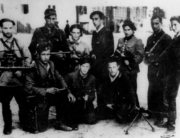
We begin with an opening in a wooden wall, presumably the side of a barn, where inside a large pig lies sleeping. We view her through a pristine black-and-white lens, the ground is strewn with hay, her breathing is soft. Then, as the camera zooms in slowly, her babies emerge, squeaking, snorting, climbing all over her. It is not an easy process for them to rouse her nor is it a simple, uncompetitive process for them to procure milk from her udders. Their lives, as this experimental documentary aims to show us, are complex and varied.
Besides pigs, we also spend time with chickens and cows, three common sources of meat, though this is never overtly stated (nothing is—the documentary has no narration or dialogue or music). The pigs, however, are the ones most featured as we watch the piglets grow. The actions in this film are outwardly simple. We observe these animals around the farm and in nature living their lives. The pigs vie for nourishment, wallow in the mud, nap, explore the outdoors, huddle together for warmth. The chickens essentially emerge from a coop and explore an area of tall grass, and the cows leave the confines of the farm to graze in a pasture.
As is clear from the description above, this is not a film that contains much action in the traditional sense. Yet, if director Victor Kossakovsky (Aquarela) achieves one thing here, it is to imbue his subject with dignity and film these animals with specificity and focus that suggests an entry into a world just out of our grasp. The soundscape beautifully conveys the fullness of the natural sounds that surround them. The photography is beautiful, carefully composed, and speaks to Kossakovsky’s eye for detail. There is a compelling interest in animals’ bodies and their uniqueness—such as the way chickens move their feet—and with the struggles and preoccupations specific to them, whether it be brushing away flies (as the cows do) or negotiating one’s way around a log with one leg (as a certain chicken does). The pigs are often rim lit, which suggests that the director intends us to view them as almost noble.
Gunda is also undeniably difficult viewing. Its pace is deeply conducive to audience members losing attention. Criticizing it on these grounds is tricky, as this is part of the point, and watching it could also be a very different experience in a movie theater rather than streaming it at home. Kossakovsky demands that we take the time to consider these beings and to move at their pace, consider their unique worlds, without any comment or attempt to shape their interactions into a linear narrative.
There are startling images and sequences, one of them genuinely tragic, but one needs constantly to fight to stay interested in the film. Even if one recognizes the director’s intentions, it is harder to determine whether or not the rewards justify the demands he makes. I say that as someone who enjoys slow, often quiet films by Tarkovsky, Victor Erice, and others, and who is often frustrated when people complain if a film, book, or play requires effort on their part. Yes, many of us (I’m guessing) do not often take the time to consider the inner lives of the animals the meat industries depend on, and it is potentially a compelling idea. Yet, without the shaping hand of the director to rivet our attention toward these animals, their experience—and their richness—threatens to recede. One has the sense that this film is an unfinished experiment, even if one is grateful that this is cinema that genuinely does experiment.
Nevertheless, of the three nontraditional documentaries I have reviewed recently (Notturno and Space Dogs being the other two), Gunda is easily the best, as one cannot deny that the challenges it poses to the viewer are intentional. Yet it might not be challenging for all viewers. I’m guessing that, for those with a PhD in animal behavior, this film will be heaven, as they will be able to see much more than the average viewer.






Leave A Comment